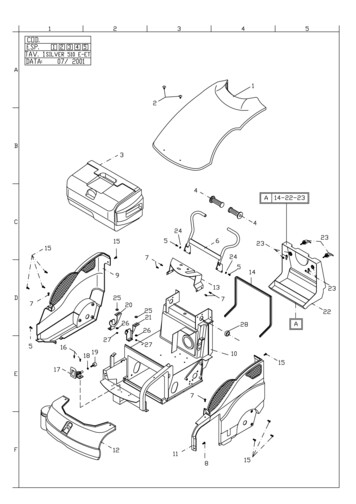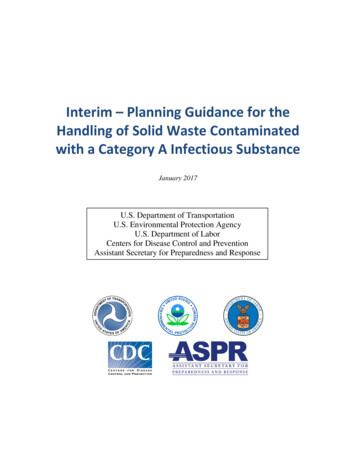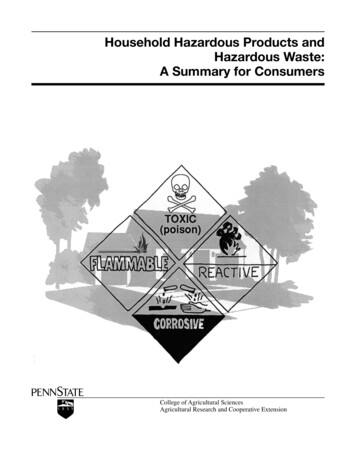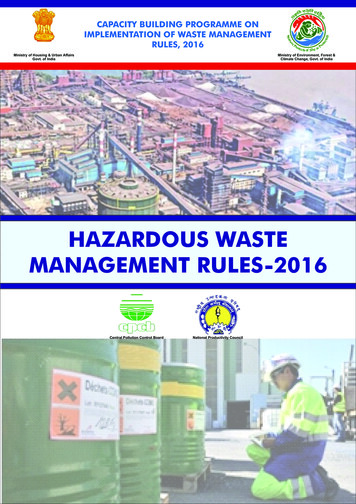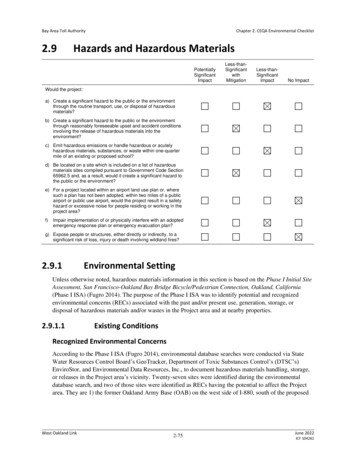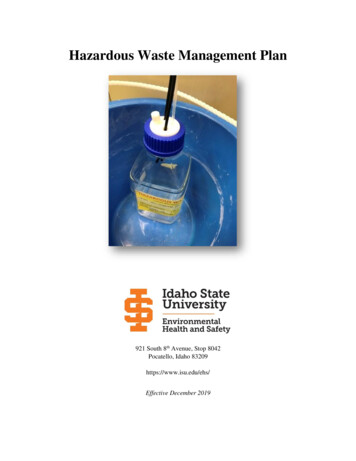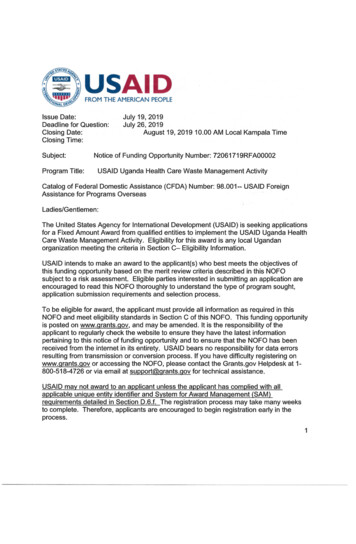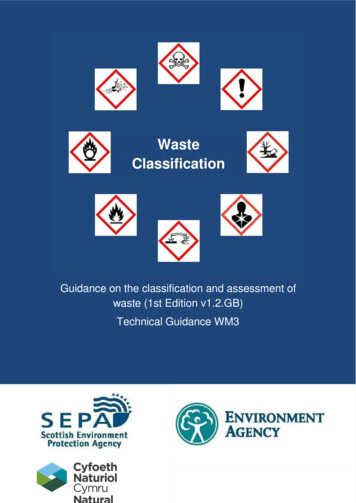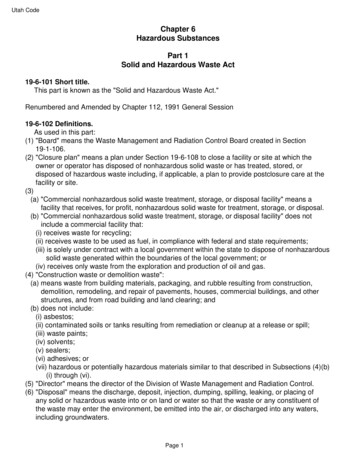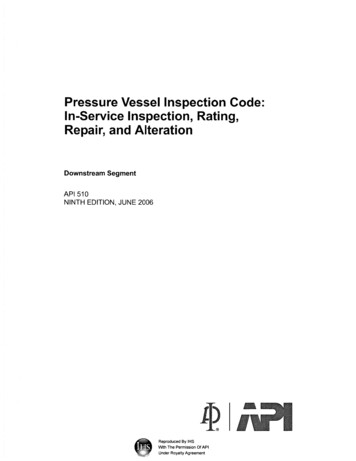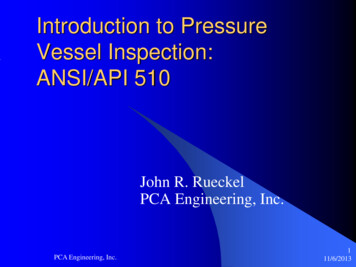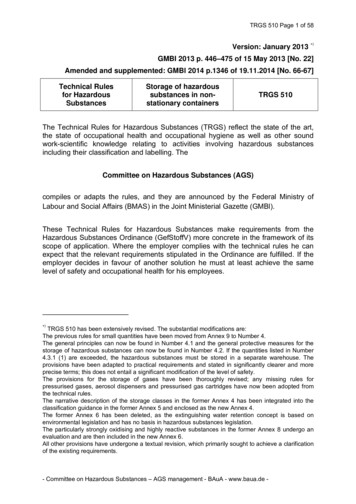
Transcription
TRGS 510 Page 1 of 58Version: January 2013 GMBI 2013 p. 446–475 of 15 May 2013 [No. 22]Amended and supplemented: GMBl 2014 p.1346 of 19.11.2014 [No. 66-67]Technical Rulesfor HazardousSubstancesStorage of hazardoussubstances in nonstationary containersTRGS 510The Technical Rules for Hazardous Substances (TRGS) reflect the state of the art,the state of occupational health and occupational hygiene as well as other soundwork-scientific knowledge relating to activities involving hazardous substancesincluding their classification and labelling. TheCommittee on Hazardous Substances (AGS)compiles or adapts the rules, and they are announced by the Federal Ministry ofLabour and Social Affairs (BMAS) in the Joint Ministerial Gazette (GMBl).These Technical Rules for Hazardous Substances make requirements from theHazardous Substances Ordinance (GefStoffV) more concrete in the framework of itsscope of application. Where the employer complies with the technical rules he canexpect that the relevant requirements stipulated in the Ordinance are fulfilled. If theemployer decides in favour of another solution he must at least achieve the samelevel of safety and occupational health for his employees. TRGS 510 has been extensively revised. The substantial modifications are:The previous rules for small quantities have been moved from Annex 9 to Number 4.The general principles can now be found in Number 4.1 and the general protective measures for thestorage of hazardous substances can now be found in Number 4.2. If the quantities listed in Number4.3.1 (1) are exceeded, the hazardous substances must be stored in a separate warehouse. Theprovisions have been adapted to practical requirements and stated in significantly clearer and moreprecise terms; this does not entail a significant modification of the level of safety.The provisions for the storage of gases have been thoroughly revised; any missing rules forpressurised gases, aerosol dispensers and pressurised gas cartridges have now been adopted fromthe technical rules.The narrative description of the storage classes in the former Annex 4 has been integrated into theclassification guidance in the former Annex 5 and enclosed as the new Annex 4.The former Annex 6 has been deleted, as the extinguishing water retention concept is based onenvironmental legislation and has no basis in hazardous substances legislation.The particularly strongly oxidising and highly reactive substances in the former Annex 8 undergo anevaluation and are then included in the new Annex 6.All other provisions have undergone a textual revision, which primarily sought to achieve a clarificationof the existing requirements.- Committee on Hazardous Substances – AGS management - BAuA - www.baua.de -
TRGS 510 Page 2 of 58Table of contents1Scope of Application2Definitions3Risk assessment4General measures for safety and health protection5Additional measures for special hazardous substances6Fire protection measures7Joint storage8Storage of liquids and solids of acute toxicity.9Storage of oxidising liquids and solids10Storage of pressurised gases11Storage of aerosol dispensers and pressurised gas cartridges12Storage of flammable liquidsLiteratureAnnex 1:Additional information on risk assessmentAnnex 2:Storage of hazardous substances in sales areas and residentialpremisesAnnex 3:Storage of flammable liquids in safety cabinets in workroomsAnnex 4:Methodology for classification of storage classesAnnex 5:Special fire- and explosion-protection measuresAnnex 6:Other strongly oxidising or highly reactive substances1Scope of application(1) TRGS 510 shall apply to the storage of hazardous substances in non-stationarycontainers including the following (handling) activities1.Storage and removal from storage facility,2.Transport inside the warehouse,3.Removal of released hazardous substances.Storage is the keeping for later use and for delivery to others. It includes holdingavailable for transport if the transport is not conducted within 24 hours after the itemsconcerned have been made available or on the following working day. If this workingday is Saturday, the deadline shall end at the end of the next working day.- Committee on Hazardous Substances – AGS management - BAuA - www.baua.de -
TRGS 510 Page 3 of 58(2) In addition to the measures described in number 4, numbers 5 to 12 shall applyto special hazardous substances listed in Table 1 where the respective thresholdquantities have been exceeded. The threshold quantity shall be deemed to be theaggregate amount of hazardous substances with the respective classification orproperty. The table includes the classifications pursuant to Regulation (EC)1272/2008 (CLP-Regulation), as well as pursuant to the EU Dangerous SubstancesDirective 67/548/EEC and/or the Dangerous Preparations Directive 1999/45/EC. Upuntil 1 June 2015 the employer is free to decide on which classification system hewishes to base his calculations. In order to avoid contradictions the two classificationsystems should not be used side by side.(3) The threshold quantity in Table 1 indicates the aggregate quantity above whichthe measures specified in the individual numbers must be taken.Table 1: Application of numbers 4 to 12 and annexes 1 to 6Classification/propertyHazard statementaccording toCLP-RegulationR-phraseaccording toEC DirectiveAll hazardoussubstancesPermittedstorageoutside ofwarehouses,taking intoaccountno. 4.2Additional and specialprotective measuresUp to 1,000 kgunlessotherwisestated belowNo. 4.3 1,000 kgIn the case of jointstorage, no. 7 200 kgAcutely toxic hazardoussubstancesH300, H301,H310, H311,H330 or H331a)R23 to R28Up to 50 kgNo. 5 and no. 8 each 200 kgCarcinogenic andmutagenic hazardoussubstancesH340, H350,H350iR45, R46, R49Up to 50 kgNo. 5 200 kgHazardous substanceswith special toxicpropertiesH370,R39/23 toR39/28Up to 50 kgNo. 5 200 kgHighly and extremelyflammable liquidsH224, H225Up to 20 kg, ofwhich up to10 kg isextremelyflammableNo. 5, no. 6 and no. 12each 200 kgH372R48/23 toR48/28R11, R12Annexes 2, 3 and 5 mustalso be taken intoconsideration- Committee on Hazardous Substances – AGS management - BAuA - www.baua.de -
TRGS 510 Page 4 of 58Flammable liquidsH2261R10Up to 100 kgNo. 5, no. 6 and no. 12each 1,000 kgAnnexes 2, 3 and 5 mustalso be taken intoconsiderationFlammable solidsH228R11No. 6 200 kgPyrophoric substancesand mixturesH250R17No. 5 and no. 6 each 200 kgSelf-heatingsubstances andmixturesH251, H252No. 6 200 kgSelf-reactivesubstances andmixturesH242No. 6 200 kgOxidising liquids andsolidsH271, H272stated in annex 6R8, R9Up to 1 kgNo. 5 and no. 9 each 5 kgH272, unlessstated in annex 6.R8, R9Up to 50 kgNo. 5 and no. 9 each 200 kgUp to 2.5 lNo. 10 2.5 lGases in gas cartridges b)H280, H281H220, H221R12Up to 2.5 lNo. 5 and no. 6 each 200 kg and no. 10 2.5 lH270R8Up to 2.5 lNo. 5 200 kg andno. 10 2.5 lH220, H221R12Up to 20 kgWhere applicable,Annex 2 0 kgNo. 6 200 kgNo. 11 20 kgH222, H223-Up to 20 kgWhere applicable,Annex 2 0 kgNo. 6 200 kgNo. 11 200 kgHazardous substancesthat are fromexperience flammableCombustible liquidsH260, H261Without marking:storage class 10R15Up to 200 kgNo. 6 200 kgUp to 1,000 kgNo. 6 1,000 kg1If only flammable liquids with a flashpoint greater than 55 C are stored, the definition ofsupplementary/additional protective measures beyond the requirements of no. 4 can be dispensedwith based on the results of the risk assessment in accordance with no. 3. This relates in particular todiesel fuel and heating oil.- Committee on Hazardous Substances – AGS management - BAuA - www.baua.de -
TRGS 510 Page 5 of 58Combustible solidsa)b)Without marking:storage class 11as well as othersolid hazardoussubstances thatare fromexperienceflammableTo bedetermined bythe employer,normally onthe tonnescaleTo be determined by theemployer, normally onthe tonne scaleWithin the framework of the risk assessment, the employer can disregard those substancesand mixtures that are not classifiable as toxic or very toxic in accordance with Directive67/548/EEC for the determination of protective measures for acutely toxic substances.These rules shall equally apply to unmarked aerosol dispensers and pressurised gascartridges.(4)The present TRGS shall not apply1.to substances that are part of a production or work process or to the holding ofnon-stationary pressurised gas containers ready for use,2.to activities as e.g. decanting and retrieval, cleaning of containers, sampling,maintenance and repair work,3.to bulk materials stored in bulk,4.to explosive substances and mixtures that fall within the scope of the ExplosivesAct; these are subject to the second ordinance to the Explosives Act(2. SprengV) with regard to storage,5.to ammonium nitrate and mixtures/preparations that contain ammonium nitratethat fall within the scope of Annex I (5) of the Hazardous SubstancesOrdinance; these are subject to TRGS 511 “Ammonium nitrate”,6.to organic peroxides that fall within the scope of accident-prevention regulation2BGV B4 ; this shall not affect the rules laid down in numbers 3 and 4 of thesetechnical rules insofar as they supplement BGV B4,7.to radioactive materials that are subject to the Atomic Energy Act and/or theRadiation Protection Ordinance,8.to infectious substances.Where activities are carried out in the warehouse pursuant to no. 2 they shall beseparately assessed in the risk assessment procedure according to TRGS 400 "Riskassessment in conjunction with the handling of dangerous substances" and thenecessary protective measures shall be equally taken. Contrary to sentence 1, theprovisions of number 7 “Joint storage” must be taken into consideration forradioactive and infectious substances.(5) Requirements from other areas of law, in particular construction law, theOrdinance on Industrial Safety and Health, the Water Management Act, lawsgoverning the transport of dangerous goods, the Immission Control Law and2It is intended to replace the accident-prevention regulation BGV B4 with a technical rule (TRGS). Assoon as the technical rule is published, it shall apply accordingly.- Committee on Hazardous Substances – AGS management - BAuA - www.baua.de -
TRGS 510 Page 6 of 58Hazardous Incident Reporting Ordinance shall remain unaffected.2Definitions(1) These technical rules list the classifications pursuant to Regulation (EC) No.1272/2008 (CLP-Reg.), but also pursuant to EU Directive 67/548. Terminologypursuant to the CLP Regulation shall be used for the definition of the classifications.In the following, terms are defined that are neither listed in the glossary of theOrdinance on Industrial Safety and Health nor in the Biological Agents Ordinance or3Hazardous Substances Ordinance.(2) Warehouses within the meaning of these technical rules are buildings, areas orrooms in buildings or outdoor areas whose purpose is to store hazardoussubstances. Containers or cabinets shall also be deemed warehouses.(3) A warehouse sector is the part of a warehouse that is separated from otherwarehouse sectors or adjoining rooms1.in buildings by walls and ceilings fulfilling safety requirements, or2.outdoors by reasonable distances or by walls.Safety cabinets with a fire resistance rating of at least 90 minutes shall be deemedwarehouse sectors.(4) The part of a warehouse sector in which hazardous substances are stored shallbe deemed a warehouse area.(5) Roofed outdoor warehouses shall also be deemed warehouses provided theyare open on at least two sides including warehouses that are only open on one sideprovided the width – measured from the open side – is not bigger than the height ofthe open side. A side of a room shall also be deemed to be open if it consists of awire mesh gate or a similar material which does not significantly impede the naturalventilation.(6) The storage quantity shall be the net mass of a stored hazardous substance.The total storage quantity shall be the sum of the storage quantities of the varioussubstances.(7) For the purpose of these technical rules, non-stationary containers arecontainers whose purpose is to transport and store hazardous substances. Nonstationary containers include, e.g.:1.packagings (e.g. barrels, canisters, bottles, sacks),2.intermediate bulk containers (IBCs, e.g. Big Bags or FIBCs),3.large packagings,4.tank containers/non-stationary tanks,5.pressurised gas containers (e.g. transportable pressure equipment as definedby the Transportable Pressure Equipment Ordinance (ODV) or Directive3See http://www.baua.de/cln .html- Committee on Hazardous Substances – AGS management - BAuA - www.baua.de -
TRGS 510 Page 7 of 582010/35/EU (TPED) and pressure vessels as defined by the hazardous-goodslegislation, such as bottles, large bottles, sealed cryogenic vessels, cylinderracks or multiple-element gas containers (MEGCs)),6.aerosol dispensers or pressurised gas cartridges,7.rail tank wagons, tank vehicles.(8) Pressurised gas containers are containers for gases under pressure. Apressurised gas container includes the accessories which can affect its safety. Nonstationary pressurised gas containers include transportable pressure equipment asdefined by Directive 2010/35/EU (TPED) or the Transportable Pressure EquipmentOrdinance (ODV) and pressure vessels as defined by the hazardous-goodslegislation, such as bottles, large bottles, sealed cryogenic vessels, cylinder racksand multiple-element gas containers (MEGCs).(9) An aerosol dispenser is a metal, glass or plastic container that cannot berefilled, that complies with the provisions set out in section 6.2.6 of the ADR and thatcontains a gas that is condensed, liquefied or dissolved under pressure with orwithout a liquid, pasty or powdery substance. It is fitted with a retrieval device whichallows an ejection of the contents as a suspension or of solid or liquid particles in agas, as a foam, a paste or a powder or in the liquid or in the gaseous state.(10) Pressurised gas cartridges are non-refillable containers without their ownextraction valve. Every cartridge consists of a container and a locking device for thefilling opening. Cartridges are emptied through a special retrieval device.(11) Where different substances are located within one warehouse sector, container,safety cabinet or other containment area, this shall be deemed to be joint storage.(12) The storage class is the classification of hazardous substances and mixturesintended for storage according to specific hazard indicators. The storage classesshall be used exclusively to determine the joint storage of substances.4(13) For the purpose of these technical rules, distances shall be used to:1. protect a warehouse from incidents of damage due to external factors, e.g.mechanical damage or heating as a result of a fire load;2. protect against interactions between the stored hazardous substances;3. minimise as far as possible the risk posed to employees or other persons by leaksin non-stationary containers or interruptions to the proper operating procedure.(14) Draining surfaces are surfaces that collect escaping liquids and feed them to acontainment area; they form a structural unit together with the containment area butare not intended for longer-term retention of the stored substance.(15) Potentially explosive environments are environments in which hazardous,potentially explosive atmospheres can occur.(16) Extinguishing water retention installations are installations intended to collectany contaminated extinguishing water arising in the case of a fire until it can bedisposed of.4In the previous rules, the following terms were used for this: protection distances, safety distances,separation strips and protection areas.- Committee on Hazardous Substances – AGS management - BAuA - www.baua.de -
TRGS 510 Page 8 of 58(17) A fire(-fighting) compartment is a part of the building that, in accordance withbuilding law, is separate with regard to fire protection, whereby fire is not generallyexpected to spread to other areas of the building due to the requirements for theadjoining components,(18) Liquids shall be deemed to be flammable if they have a flashpoint of up to370 C.3Risk assessment(1) In the framework of risk assessment pursuant to section 5 GermanOccupational Health and Safety Act and section 6 of the Hazardous SubstancesOrdinance the employer has to check, whether his employees or third persons areexposed to hazards caused by the storage of hazardous substances. For theimplementation of the risk assessment see in particular TRGS 400.(2) Hazards can be caused by the storage of hazardous substances in particularbecause of1.properties and/or the aggregate state of the stored hazardous substances,2.quantity of the stored hazardous substances,3.type of storage,4.activities performed during the storage process,5.joint storage of hazardous substances,6.working and ambient conditions, in particular the type of warehouse, room size,climatic conditions, external impacts and storage period.Annex 1 includes further information on potential hazards.(3) The most important information sources for the risk assessment of thehazardous substances to be stored are the marking (pursuant to EC Directives67/548/EEC and 1999/45/EC and/or Regulation (EC) No. 1272/2008 or pursuant tothe Hazardous Substances Ordinance Road, Rail and Inland Navigation) of thehazardous substances and mixtures/preparations, the Safety Data Sheet in itscurrent version as well as supplementary information by the manufacturer. As a rulethese information sources are sufficient.(4) In case of missing or insufficient information the employer is obliged to providefurther information from other sources, see TRGS 400.(5) For the risk assessment regarding storage all activities and operationalsituations shall be considered from which a hazard might arise for the employees.These activities include in particular1.storing substances and removing them from the warehouse,2.internal transport inside the warehouse,3.removal of released hazardous substances.- Committee on Hazardous Substances – AGS management - BAuA - www.baua.de -
TRGS 510 Page 9 of 58(6) Where further activities are carried out in the warehouse, e.g. decanting andretrieval, cleaning of containers, sampling, maintenance and repair work, they shallbe considered within the framework of the hazard assessment and the additionalprotective measures above and beyond the rules laid out in these technical rulesshall be taken.(7) Where mixtures of air and flammable gases, vapours, mists or dusts may begenerated, the formation of potentially explosive atmospheres shall be investigated,areas with high explosion risks must be organised in zones, protective measuresshall be defined, and an explosion protection document shall be drafted and updatedaccording to the provisions of the Work Equipment Ordinance.(8) The necessary protective measures shall be determined according to thehazards identified. In this context the protective measures described in No. 4 of thesetechnical rules shall be taken into particular consideration.(9) Depending on the quantity and properties of the hazardous substances, not allmeasures of these technical rules need be applied. Derogations shall be defined inthe risk assessment process, if necessary.4Protective measures for safety and health protection4.1Principles(1) Hazards for the health and safety of employees and other persons and hazardsfor the environment caused by substance-related damages in connection with thestorage of hazardous substances shall be eliminated or reduced to a minimumthrough the following measures:1.Design of the warehouse and the storage facilities;2.Organisation of workflows;3.Provision of suitable equipment for activities related to the storage of hazardoussubstances, e.g. gripping devices for unpalletised barrels;4.Limitation of the period and intensity of exposure;5.Reasonable hygiene measures, in particular cleaning at regular intervals;6.Prevention of non-intentional release of hazardous substances;7.Provision of the resources to prevent hazards.(2) These measures always consist of the general protective measures set out innumber 4.2; they are also necessary for all hazardous substances in the event ofstorage outside of warehouses, regardless of whether a threshold quantity exists.(3) If the respective small quantities (see Table 1) per closed factory building orfire(-fighting) compartment or separate building unit are exceeded, at least theexcess quantities must be stored in warehouses in accordance with number 2 (2),taking additional protective measures into account. Depending on the thresholdquantities and the hazardous substances’ properties, other additional or specialprotective measures shall also apply in accordance with numbers 5 to 12(see Table 1).- Committee on Hazardous Substances – AGS management - BAuA - www.baua.de -
TRGS 510 Page 10 of 58(4) Whether other (hazardous) substances/chemicals/materials may be stored in awarehouse in addition to a hazardous substance must be checked according to therules in the numbers below, in number 7 in particular, and the information in thesafety data sheet.(5) The quantities of hazardous substances provided must be limited to the amountrequired for the day/shift; quantities in excess of these must be stored. Where smallquantities are used regularly, the smallest commercially available pack size can alsobe provided.(6)Hazardous substances must only be stored in closed packaging or containers.(7) Hazardous substances should, wherever possible, be stored in originalcontainers or original packaging. If hazardous substances are not stored in originalcontainers, it must be ensured that the storage containers are suitable and aremarked in accordance with number 4.2 (2).(8) If hazardous substances are stored, a Hazardous Substances Register must bekept (see Article 6 (10) of the Hazardous Substances Ordinance), including:1.the names of the stored hazardous substances,2.the classification of the hazardous substance or information on the hazardousproperties,3.the tonnage levels used,4.the warehouse areaand should be kept outside the warehouse, if possible; it could be sensible to have astorage plan indicating the storage classes and the associated stored quantities.4.2General us(1) The packaging and containers must be suitable for ensuring that none of thecontents can escape unintentionally. These requirements shall be deemed to havebeen met if, among other things, the packaging/containers meet the requirements forthe transport of dangerous goods.(2) The employer must ensure that all stored hazardous substances can beidentified. Hazardous substances and mixtures/preparations must be provided with amarking that contains sufficient information on the classification and that either showsthe hazards that are present during handling and protective measures that should betaken or allows these to be derived. TRGS 201 “Classification and marking foractivities involving hazardous substances” must be applied.(3) Hazardous substances must not be kept or stored in containers whose shape ormarking could lead the contents to be mistaken for foodstuffs.(4) Hazardous substances must not be stored in locations where they could pose arisk to employees or other persons. This includes, in particular:1.Traffic routes; among others, these include stairwells, escape and emergencyroutes, passageways, thoroughfares and narrow courtyards;- Committee on Hazardous Substances – AGS management - BAuA - www.baua.de -
TRGS 510 Page 11 of 582.Break rooms, duty rooms, sanitary rooms, first-aid rooms or rest rooms.Hazardous substances may only be stored in working areas if storage can beachieved in a way that is also safe for the employees. Special equipment must beused for storage if the results of the risk assessment show this to be necessary.(5) No effective ignition sources may be present in the direct vicinity of the storagecontainers containing flammable hazardous substances.(6) Filled aerosol dispensers and pressurised gas cartridges must not be heated bymore than 50 C by sunlight or other heat sources.(7) If pressurised gas cartridges with combustible contents must be stored with aretrieval device connected, these must only be stored with additional protectivemeasures – e.g. effective ventilation openings of at least 100 cm² in thewarehouse/cabinet – to avoid the formation of potentially explosive atmospheres dueto leaks in the connections.(8) If opened containers are stored, the actual storage quantity must be used incalculating the total stored volume. Contrary to the first sentence, the nominal volumemust be used for flammable hazardous substances (marked with H221, H222, H223,H224, H225, H226 or R12, R11, R10).(9) Flammable liquids (marked with H224, H225, H226 or R12, R11, R10) may bestored outside of warehouses in:1.fragile containers with a capacity of up to max. 2.5 l per container and2.non-fragile containers with a capacity of up to max. 10 l per containerprovided that the risk assessment does not indicate an increased risk of fire. Here, amaximum of 20 kg of extremely and highly flammable liquids may be contained, ofwhich no more than 10 kg may be extremely flammable liquids. It is recommendedthat flammable liquids be stored in safety cabinets in accordance with Annex 3.(10) Containers with liquid hazardous substances must be placed in a spillcontainment facility that can contain at least the capacity of the largest container.Where the generation of a hazardous, potentially explosive atmosphere cannot beruled out, the containment facilities must have ESD protection.(11) Hazardous substances must be neither kept nor stored in the immediateproximity of pharmaceuticals, food or forage, including their additives, or cosmetics,drink and tobacco. Where substances that are acutely toxic (category 1, 2 and 3),very toxic, toxic (according to Directive 67/548/EEC), carcinogenic, mutagenic ortoxic to reproduction (category 1A or 1B according to the CLP Regulation) are kept orstored together in one room, this shall be deemed to be immediate proximity. In thecase of all other hazardous substances, these should in principle be kept/stored inseparate rooms; if absolutely necessary for operational reasons, they must at leastbe separated by a horizontal distance greater than 2 m.(12) Substances and mixtures/preparations that are classified as toxic, very toxic,carcinogenic in category 1 or 2, mutagenic in category 1 or 2 or toxic to reproductionin category 1 or 2 pursuant to Annex VI of Directive 67/548/EEC shall be kept underseal or kept in such a manner that only knowledgeable and reliable persons haveaccess to them.- Committee on Hazardous Substances – AGS management - BAuA - www.baua.de -
TRGS 510 Page 12 of 58(13) Where hazardous substances are stored that are marked with the precautionarystatement P405 "Store locked up" by the person placing them on the market pursuantto Regulation (EC) No. 1272/2008 and that are not subject to the hazard indicators inparagraph 12, these shall receive the same treatment as recommended inparagraph 12.(14) The employer shall ensure that psychotropic substances subject to theNarcotics Act are kept locked away. Only the person responsible shall be permittedto access narcotics.4.3Additional protective measures for storage in warehouses4.3.1Warehouse(1) Hazardous substances must be stored in warehouses within the meaning ofthese technical rules if the following quantities per fire(-fighting) compartment/buildingor separate building unit are exceeded:1.gases in pressurised gas containers with a nominal volume of 2.5 litres or more,2.combustible liquids:a)20 kg of extremely and highly flammable liquids, of which no more than10 kg may be extremely flammable liquids,b)100 kg of flammable liquids1),c)1,000 kg combustible liquids,3.20 kg of gases in pressurised gas cartridges,4.20 kg of aerosol dispensers (net mass),5.50 kg of hazardous substances that are classified as acutely toxic cat. 1, 2 or 3or STOT cat. 1 or carcinogenic, mutagenic or toxic to reproduction category 1Aor 1B,6.1 kg of oxidising hazardous substances of cat. 1 or packing group I inaccordance with the dangerous goods legislation, as well as the hazardoussubstances listed in Annex 6,7.50 kg oxidising hazardous substances of cat. 2 or 3, unless these are listed inAnnex 6,8.200 kg of pyrophoric hazardous substances marked with H250,9.200 kg of hazardous substances that release flammable gases on contact withwater (H260, H261),10. 1,000 kg net storage mass for hazardous substances with none of the aboveproperties.Storage in warehouses in accordance with number 2 (2) is also necessary if the totalnet mass of the stored hazardous substances exceeds 1,500 kg.(2) If flammable liquids are stored in safety cabinets in accordance with Annex 3,the safety requirements laid down in number 4 shall be deemed to have been met.- Committee on Hazardous Substances – AGS management - BAuA - www.baua.de -
TRGS 510 Page 13 of 58(3) More detailed rules on the storage of flammable liquids and of aerosoldispensers and pressurised gas cartridges in living spaces and sales rooms can befound in Annex 2(4) Sufficient lighting (see ASR A3.4) must be present in warehouses and outdoorstorage areas. The lighting must be installed in such a way as to avoid heating thestored substances, which can lead to a dangerous reaction.(5) Sufficient ventilation must be provided in the warehouse (see ASR A3.6) wherea risk can be posed to employees or other persons through unintended release ofhazardous substances.4.3.2(1)Warehouse organisationHazardous substances must only be kept or stored in an orderly fashion.(2) Warehouses must be kept and operated in an orderly fashion. Measures to beobserved by employees must be documented in operating instructio
storage of hazardous substances can now be found in Number 4.2. If the quantities listed in Number 4.3.1 (1) are exceeded, the hazardous substances must be stored in a separate warehouse. The . If only flammable liquids with a flashpoint greater than 55 C are stored, the definition of
